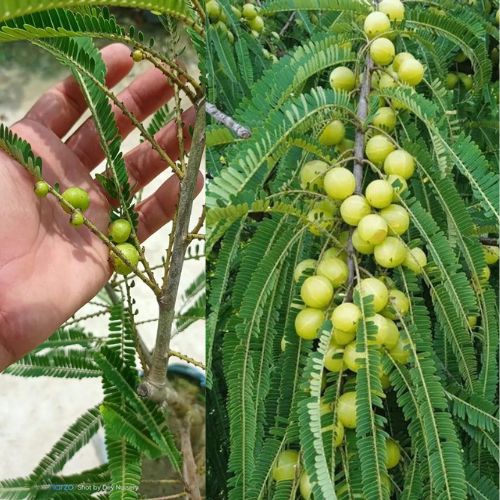
Live Plants
5 % Off on pre-paid purchase above 999/- COUPON:Newness- 5
10 % Off on pre-paid purchase above 1999/- COUPON :WELCOME-10
15 % Off on pre-paid purchase above 9999/- COUPON :SAVE-15
While Amla, also known as Indian gooseberry (Phyllanthus emblica), is not typically grafted or hybridized like some other fruit trees, there are techniques such as air layering or grafting that can be used to propagate specific varieties or cultivars with desirable traits.
However, it's worth noting that Amla is more commonly propagated through seeds or cuttings rather than grafting or hybridization. This is because Amla trees tend to grow true to type from seeds and produce fruit relatively quickly, making grafting less necessary for propagation.
Here are some general care tips for growing Green Amla Thai:
Climate: Green Amla Thai thrives in warm, tropical to subtropical climates. It prefers full sun but can tolerate some partial shade. Amla trees are relatively hardy and can withstand a range of temperatures, but they may be damaged by frost.
Soil: Plant your Green Amla Thai tree in well-draining soil with good fertility. Sandy loam or loamy soils are ideal. Ensure the soil is consistently moist but not waterlogged, as waterlogged conditions can lead to root rot.
Watering: Provide regular watering to your Amla tree, especially during dry periods and while the fruits are developing. Water deeply to encourage deep root growth, but allow the soil to dry out slightly between waterings to prevent waterlogged conditions.
Fertilization: Amla trees benefit from regular fertilization to support healthy growth and fruit production. Use a balanced fertilizer formulated for fruit trees and apply it according to the manufacturer's instructions during the growing season.
Pruning: Prune your Amla tree as needed to remove dead or diseased branches, improve airflow within the canopy, and maintain its desired shape and size. Pruning can also help promote fruit production and reduce the risk of pest and disease problems.
Pest and Disease Control: Monitor your Amla tree regularly for signs of pests, such as aphids, scale insects, or fruit flies, as well as diseases like powdery mildew or leaf spot. Take appropriate measures, such as applying insecticides or fungicides, if necessary.
Harvesting: Amla fruits typically mature in late summer to early fall, depending on the climate. Harvest the fruits when they are fully ripe and have developed their characteristic color and flavor. Use a sharp knife or scissors to cut the fruits from the tree, taking care to avoid damaging the branches.
By providing proper care and attention, your Green Amla Thai tree can thrive and produce an abundance of nutritious fruit for many years. Enjoy the process of nurturing your tree and savoring the unique flavor and health benefits of Amla fruits!
NewnessPlant partnered with so many nursery and have few own nursery to fulfill all your needs and available any kind of plants and seeds.